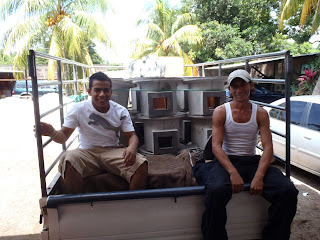In 8 days, we got 1.5 meters of rain. That’s about 5 feet—58 inches to be a bit more exact. El Salvador’s average annual rainfall is 1.8 meters, and we had already hit that mark for the year, even before the most recent rains. Across El Salvador, and most of Central America, that meant problems (with aquifers already full and soil unable to hold anymore water) such as severe flooding and landslides. The most recent numbers I’ve seen for El Salvador 34 dead, over 56,000 evacuated from their homes and in shelters, and over 1,000,00 affected, all in a country the size of Massachusetts.
The good news, at least for me and my community, San Luis, is that we are relatively high and very hilly, meaning we were in much less danger. The majority of the really bad damage in El Salvador was in low-lying areas near rivers and in the coastal zones. While crops were damaged, San Luis came out on the better end of that situation as well. While 45% of the national corn crop and 60% of the bean harvest are estimated lost, San Luis’s losses were much less, and will be more than made up for by the now much higher prices for basic grains. Farmers in my community, in a strange twist, will now end up making more money from their crop, since although they will have a little less to sell they will be selling it at much higher prices.
During my week of torrential rain, I basically went into hibernation mode, with absolutely no desire or need to leave my house. In all, I ate Oreos, watched about 10 movies (Machete and Resevoir Dogs are new favorites and I was pleasantly reminded why I used to like Shawshank Redemption so much), ate more Oreos, read 5 books, finished all 10 1-hour episodes of a World War II documentary (Band of Brothers), then ate more Oreos. It literally would rain for 12 hours straight, drizzle for an hour or two, then go right back to downpour-status…nd I relaxed in my hammock through all of it. While the first 3 or 4 days were actually kind of nice and I very quickly learned to enjoy the forced period of relaxation, the last 3 days certainly got a bit painful and found me playing a lot more Solitaire than I ever though I’d play, at least before my post-retirement days.
The only serious damage to San Luis was the effect of the rain’s runoff on the road. There is just one road in San Luis, and although it was hardly passable in anything but a pickup before, it became difficult to even walk by the end of the deluge. So I convinced the nearby sugar cane processing factory to donate the use of one of its heavy tractors and the sugar cane cooperative to lend us three of their large trucks on Saturday, and all the men of the community came out to “repair” the road. My plan got off to a rough start when one man started trimming overgrown roadside weeds with a Weed Whacker the sugar plant had also loaned me for the day. Little did I know, no one in San Luis had ever seen a Weed Whacker before. Also, little did I know, apparently Weed Whackers are very interesting to those who have never seen them before. Everything was delayed an hour and a half (on top of the normal Salvadoran two-hour delay just because people are always very late) while everyone watched the Weed Whacker make quick work of the overgrown grasses then one man, still drunk from the night before, joke about cutting his beard with the spinning plastic, then end up having to go home early with quite a few mean bruises across face.
In the end, however, the day was highly successful, and San Luis’s road is once again passable. Some pictures of the day’s work are included below, along with a picture of a giant snake me and a kid from my community killed during a quick break in the rain. He took it home and his Mom cooked it up for dinner; I really wanted to go over and at least try a bite or two, but by that time it had once again started pouring rain and I decided again roasted snake and in favor of my hammock.




















